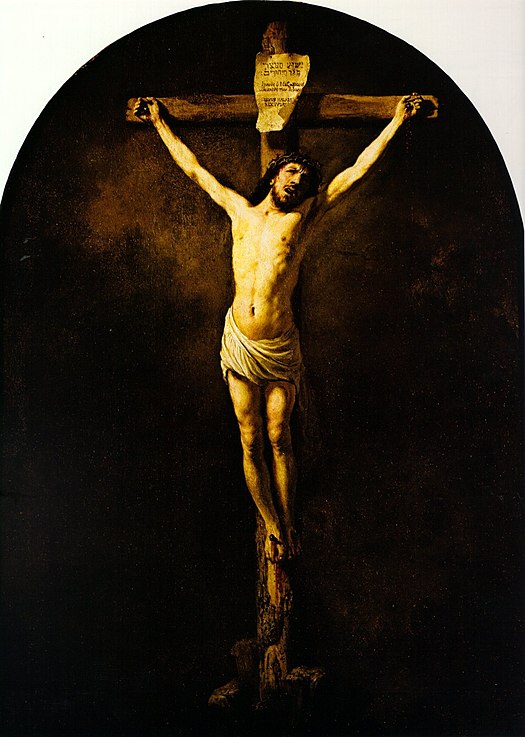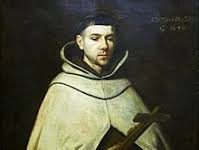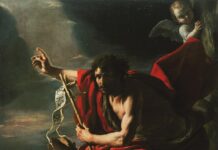One of the soldiers pierced his side with a spear, and at once blood and water came out. He who saw this has testified so that you may believe. His testimony is true, and he knows that he tells the truth (Jn. 19:34-35). ⧾
The reading of the Passion of Our Lord according to St. John on Good Friday is a climax of the liturgy of Lent; and the piercing of Our Lord’s side is the climax of the Gospel of St. John. The Cross is the goal to which all the gospels steadily move because the Cross is the fullest revelation of the nature of God; and by extension, of a properly ordered human nature. On this Good Friday, in spirit we find ourselves on mount Calvary a place situated in the land of Moriah where in obedience to God’s command, Abraham brought his son Isaac; that he might offer him in sacrifice. We are all familiar with the account of that event and how God blessed Abraham and his descendants. So Abraham called the name of that place The Lord will provide and it is said to this day, ‘On the mount of the LORD he will be seen’ (Gen. 22:14).
The Passion and Death of the Son of God is the culmination of a process of gradual and progressive revelation; of God’s self-disclosure as a God of compassionate love and of loving providence. What began with Adam, the father of the human race and with Abraham, our father in faith, continued as the mystery of salvation gradually unfolded until in the fullness of time, God became visible in the Redemptive Incarnation, in the Paschal Mystery, the Passover of the Lord. There was much proclaimed by the prophets about the mystery of the Passover: that mystery is Christ… It is he who endured every kind of suffering in all those who foreshadowed him. In Abel, he was slain, in Isaac bound, in Jacob exiled, in Joseph sold, in Moses exposed to die. He was sacrificed in the Passover lamb, persecuted in David, dishonoured in the prophets … It is he who was made man of the Virgin, he who was hung on a tree. On the tree no bone of his was broken; in the earth his body knew no decay. He is the One who rose from the dead, and who raised man from the depths of the tomb (From an Easter homily by St Melito off Sardis).
This we know because of Our Lord’s glorious Resurrection, by which we see all things and understand all things, and most especially endeavour to understand ourselves, who in Christ, are raised from the depths of the tomb. Without the events of Holy Week, we could not believe in the God who, as Pope Benedict XVI has written, created the universe in order to enter into a history of love with mankind. The pope explains further: only if it is true that the universe comes from freedom, love and reason, and that these are the real underlying powers, can we trust one another, go forward into the future, and live as human beings.
So Abraham called the name of that place The Lord will provide and it is said to this day, ‘On the mount of the LORD he will be seen’ (Gen. 22:14).On Mount Calvary, God is seen and He reveals Himself fully as self-giving Love. The history of salvation which culminates in the Paschal Mystery reveals a God whose love and providential care embrace a humanity wounded and blinded by sin and pride. Thus in His Passion and Death God Himself provides us with a model to imitate in both humility and patience without which, man falls prey to the lust of domination and a rebellious spirit that ultimately sees the universe and by extension Man, as the products of darkness and unreason. Those who most zealously espouse this view also rebel against God’s natural order and in so doing become dangerously unreasonable.
The struggle with unreason has rather quickly become the struggle of our times; and if we wish to go forward into the future and live an authentically human life, we must proceed by the light of God’s revealed truth, which is both immutable and liberating. Strength to undertake this battle is ours through the Passion of Our Saviour and so we pray always, Passion of Christ, strengthen me. St. Thomas Aquinas teaches us that the Passion of Christ completely suffices to fashion our lives because the cross exemplifies every virtue. The memory of Our Lord’s Passion however, is not for us simply a yearly event. Indeed, we firmly believe that in the Sacred Banquet of the Eucharist, in each celebration of the Holy Sacrifice of the Mass, the memory of Christ’s Passion is renewed; and moreover, the soul is filled with grace and to us is given a pledge of our future glory (O Sacrum Convivium). Hence we endeavour to live and intensely Eucharistic life.
Especially as we contend with the faulty and dangerous anthropology of transgenderism, we do well to recall that the Church teaches and that we believe that by His Incarnation, he, the Son of God, in a certain way united himself with each man… Born of the Virgin Mary, he has truly been made one of us, like to us in all things except sin, he, the Redeemer of man (Pope John Paul II, Encyclical Redemptor hominis, 8). We do well to remember this truth in light of the calls we hear for radical inclusion and most especially in light of a synod exhorting us to enlarge the space of your tent (Is. 54:2). In one sense, the tent does not need to be enlarged because it was enlarged through the Incarnation when the Son of God assumed our common human nature. No one in principle, is excluded. A tent however, is a temporary dwelling, and we know that when the earthly tent we live in is destroyed, we have a building from God, a house not made with hands, eternal in heaven…He who has prepared us for this very thing is God (2 Cor, 5:1, 5). For God so loved the world that he gave his only Son, that whoever believes in him, should not perish but have eternal life (Jn. 3:16). So our eyes are set on an eternal dwelling, the city of the living God, the heavenly Jerusalem (Heb. 12:22); and we pray and work for the conversion of all people without distinction to the faith of Jesus Christ. The Crucified Saviour beckons all men to salvation from the Altar of the Cross and it is through faith in Him and the power and efficacy of His sacrificial death that our journey to the heavenly Jerusalem begins for He will change our lowly body to be like his glorious body, by the power which enables him even to subject all things to himself (Phil. 3:21).
One of the soldiers pierced his side with a spear, and at once blood and water came out. He who saw this has testified so that you may believe. His testimony is true, and he knows that he tells the truth (Jn. 19:34-35). This detail is not recorded in any of the other gospels; and St. John assures us of the trustworthiness of what is recounted. Its meaning is profound both in itself and in its relation to our lives. We read in the Epistle to the Hebrews: Therefore, brethren, since we have confidence to enter the sanctuary by the blood of Jesus, by the new and living way which he opened for us through the curtain, that is, through his flesh (Heb. 10:19-20). This is the flesh of our shared human nature; and by faith, our flesh sanctified and divinized by sacramental grace is a marvelous example of grace building on nature. St. John Chrysostom explains: If you desire further proof of the power of this blood, remember where it came from, how it ran down from the Cross, flowing from the Master’s side. The gospel records that when Christ was dead, but still hung on the Cross, a soldier came and pierced his side with a lance and immediately there poured out water and blood. Now the water was a symbol of baptism and the blood, of the holy Eucharist. The soldier pierced the Lord’s side, he breached the wall of the sacred temple, and I have found the treasure and made it my own. (From the Catacheses by St. John Chrysostom). It is all part of God’s plan; then and even now. Our Lord has opened for us and for all humanity a way to God through His sacred humanity.
As we gaze on Him who was pierced for our transgressions [and] crushed for our iniquities (Is. 53:5) the prophecy of Zechariah is fulfilled and we look on him whom they have pierced (Jn. 19:37). So Abraham called the name of that place The Lord will provide and it is said to this day, ‘On the mount of the LORD he will be seen’ (Gen. 22:14). Prophecies fulfilled, pledges made and ratified, faith rewarded, hope renewed; the fullness of life is ours in Christ Jesus the Saviour. The Solemn Prayers of the Good Friday Liturgy embrace the whole breadth of humanity: clergy and laity, governors and rulers, believers and unbelievers. We curse no one on this day when the Son of God died for the world’s salvation; but we pray that all people be brought to the saving knowledge of Jesus Christ for there is salvation in no one else, for there is no other name under heaven given among men by which we must be saved (Acts 4:12).
As we commemorate the Passion of Our Saviour, we unite ourselves with Our Lady of Sorrows and the faithful disciples at the foot of the Cross. In them we recognise the first gathering of a faithful remnant (Cf. Rom. 11:5); and from them we endeavour to learn to remain steadfast in the truth of Christ, no matter the worldly consequences. Our personal conversion to goodness, purity, humility, gentleness, charity, to courage and penance and even suffering patiently borne out of love for God enables us to reflect and reveal God’s loving plan for a frail and broken humanity. So we become both partakers of the divine nature and cooperators in the truth of God that endures forever (veritas Domini manet in aeternum).











